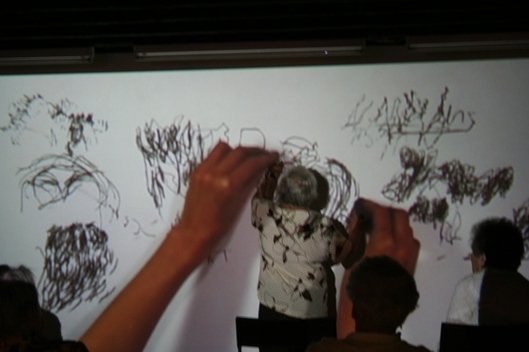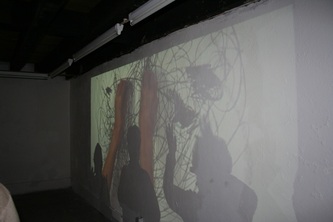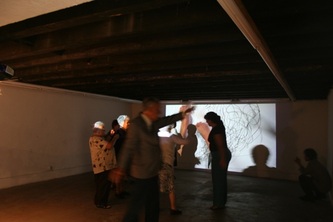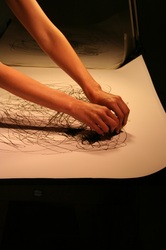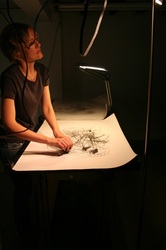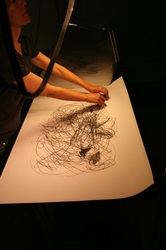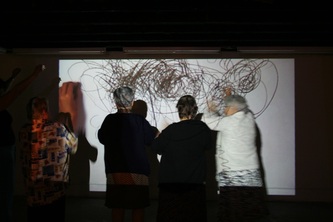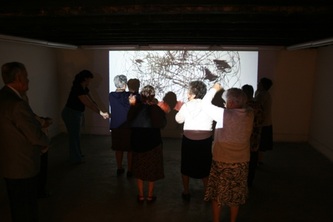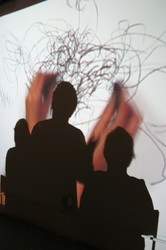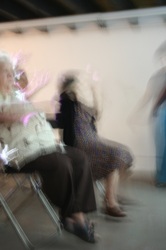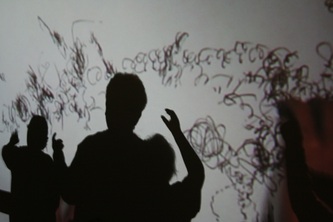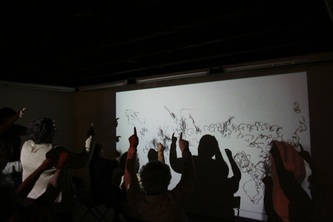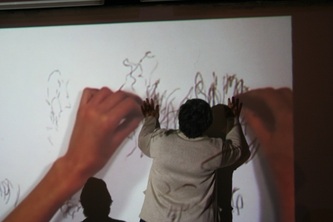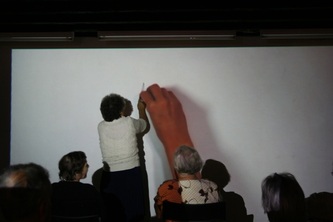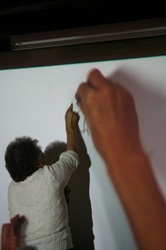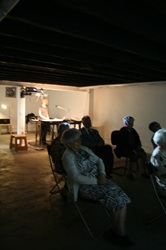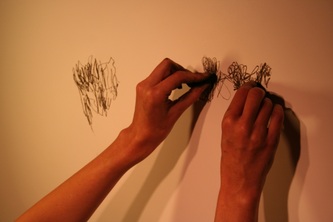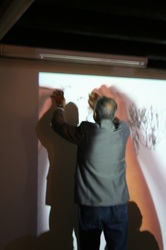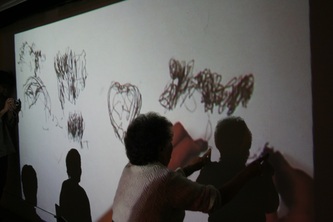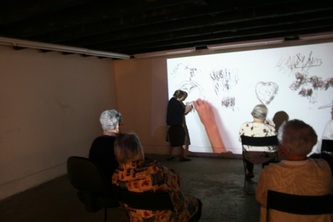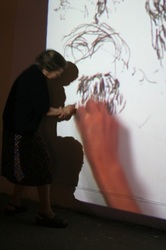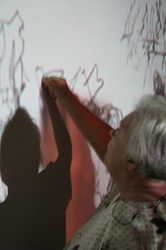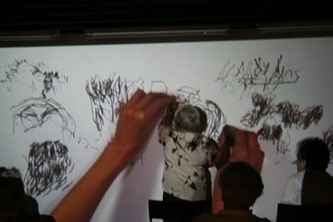_© All rigths reserved to Associação Espaços do
Desenho-Drawing Spaces. Text.Sound.Video.Images
_
DRAWING, DANCING
AND SEEING OUR TRACES
WORKSHOP Developed as a response to the project
‘GESTURE & TRACE’ by pedro janeiro
(artist residency which took place at Drawing Spaces during June 2010)
Drawing Spaces, Fábrica Braço de Prata
Lisbon, Portugal
18 JUNE 2010
AND SEEING OUR TRACES
WORKSHOP Developed as a response to the project
‘GESTURE & TRACE’ by pedro janeiro
(artist residency which took place at Drawing Spaces during June 2010)
Drawing Spaces, Fábrica Braço de Prata
Lisbon, Portugal
18 JUNE 2010
REPORT 7 -
IDEAL
Intercultural Drawing for European Adult Learning
Intercultural Drawing for European Adult Learning
WHAT
A workshop organized for a group of senior participants focused on drawing, dancing and ‘seeing’ one’s traces
WHERE
Drawing Spaces, Fábrica Braço de Prata, Lisbon, Portugal
WHEN
18 June 2010, 15.00 – 19.00h
WHO
facilitators and staff
Rochelle Haley
Teresa Carneiro
João Carneiro
1 Female Care Assistant from Mansão D. Pedro IV
ADULT LEARNERS
12 male and female senior residents from Mansão D. Pedro IV (Home Care Centre), Marvila, Lisbon, Portugal.
why
During June 2010, the artist Rochelle Haley from Australia was the artist in residence at Drawing Spaces with a project called ‘Gesture & Trace’. Developed in collaboration with four Portuguese dancers – Inês Tarouca, Joana Ratão, Patrícia Cabral and Pricilla Carbone – this project had the purpose of exploring drawing as an embodied and performative activity. Throughout a series of daily performances, the movements of one of the dancers were captured by the artist and transformed into a series of drawn lines which were simultaneously filmed and projected onto a wall, serving as coordinates for the other dancers to improvise upon. Drawing, dancing and ‘seeing’ our traces was an activity directed to some of the residents from Mansão D. Pedro IV (a Home Care Centre), which was developed in response to the project Gesture & Trace and was carried in collaboration with the artist Rochelle Haley.
HOW
VALUE FOR PARTICIPANTS
Participants who came from a very specific community of people who generally have no contact with drawing workshop engaged very smoothly in the proposed activities, without any anxieties of having to deal with something unfamiliar to them which could be very intimidating if presented more formally.
The workshop made the participants feel very released from their physical limitations as they were encouraged to experiment moving their bodies and engaging with the activities in their own time and pace.
Despite their physical limitations, participants related extremely well to an activity involving their whole bodies and encouraging group engagement.
VALUE FOR FACILITATORS
Facilitators understood that it was easier to communicate the aims of the project to the participant by doing, rather than by providing a verbal explanation. The language barrier between the artist who only spoke English and the participant who only understood and spoke Portuguese was thus easily transposed, without much need of verbal translation. Artist, facilitators and participants communicated and evolved from one part of the workshop session to another by experimenting, dancing, moving the bodies, observing what happened with the projected image and responding to what was happening in a slow and fluid way.
It became very clear to the facilitators how such an activity could act as a very effective way to communicate an engage people in their participation. Drawing was seen as an extremely effective tool to communicate and relate to others, beyond language barriers and physical limitations.
VISUAL RECORDS
A workshop organized for a group of senior participants focused on drawing, dancing and ‘seeing’ one’s traces
WHERE
Drawing Spaces, Fábrica Braço de Prata, Lisbon, Portugal
WHEN
18 June 2010, 15.00 – 19.00h
WHO
facilitators and staff
Rochelle Haley
Teresa Carneiro
João Carneiro
1 Female Care Assistant from Mansão D. Pedro IV
ADULT LEARNERS
12 male and female senior residents from Mansão D. Pedro IV (Home Care Centre), Marvila, Lisbon, Portugal.
why
During June 2010, the artist Rochelle Haley from Australia was the artist in residence at Drawing Spaces with a project called ‘Gesture & Trace’. Developed in collaboration with four Portuguese dancers – Inês Tarouca, Joana Ratão, Patrícia Cabral and Pricilla Carbone – this project had the purpose of exploring drawing as an embodied and performative activity. Throughout a series of daily performances, the movements of one of the dancers were captured by the artist and transformed into a series of drawn lines which were simultaneously filmed and projected onto a wall, serving as coordinates for the other dancers to improvise upon. Drawing, dancing and ‘seeing’ our traces was an activity directed to some of the residents from Mansão D. Pedro IV (a Home Care Centre), which was developed in response to the project Gesture & Trace and was carried in collaboration with the artist Rochelle Haley.
HOW
- Participants were taken to Drawing Spaces to engage with the set up that had been arranged for the series of performances developed in the project Gesture & Trace.
- ‘Fado’ songs (a traditional Portuguese way of singing) were audio-played and the participants were encouraged to respond with slow body movements, arm gestures, and dance.
- The artist followed the participants’ movements while drawing with both hands at the same time, and by alternating from following the gestures of one participant to following the gestures of another participant.
- At the same time, as the drawings were being produced by the artist, they also appeared projected on a big wall on the opposite side of the room.
- The participants started to realize that they could ‘see’ their gestures traced on the wall, so their movements became calmer, more controlled and their action became more intentional.
- Participants then engaged on a number of experiences as a group while moving and dancing, by responding and following each other’s gestures which they could see projected and moving on the wall.
- Then, one by one, each participant was encouraged to directly ‘draw’ with their hands or fingers on the big wall, using one or both hands at the same time, still following the sounds of ‘fado’ music.
- At the same time, the artist followed the movements of the participant who was creating and tracing a drawing on the wall, while she drawing the participant’s movements with one or both hands on paper.
- The artist’s drawings were simultaneously filmed and projected onto the big wall where the participant was performing and creating his/her movements. In this way, any gesture that the participant made seemed to have an immediate appearance on the wall.
- Some of the participants even looked at their fingers at the end of their ‘performance’ to look for vestiges of black pencil after seeing his/her traces projected on the wall.
- Looking at the wall from the back it seemed as if the participant’s hands were being helped by a pair of very large scale hands to held their own fragile bodies and hand while tracing their drawing.
- While one participant drew the rest of the participants sat behind him/her as an audience while responding very spontaneously to what was being drawn.
VALUE FOR PARTICIPANTS
Participants who came from a very specific community of people who generally have no contact with drawing workshop engaged very smoothly in the proposed activities, without any anxieties of having to deal with something unfamiliar to them which could be very intimidating if presented more formally.
The workshop made the participants feel very released from their physical limitations as they were encouraged to experiment moving their bodies and engaging with the activities in their own time and pace.
Despite their physical limitations, participants related extremely well to an activity involving their whole bodies and encouraging group engagement.
VALUE FOR FACILITATORS
Facilitators understood that it was easier to communicate the aims of the project to the participant by doing, rather than by providing a verbal explanation. The language barrier between the artist who only spoke English and the participant who only understood and spoke Portuguese was thus easily transposed, without much need of verbal translation. Artist, facilitators and participants communicated and evolved from one part of the workshop session to another by experimenting, dancing, moving the bodies, observing what happened with the projected image and responding to what was happening in a slow and fluid way.
It became very clear to the facilitators how such an activity could act as a very effective way to communicate an engage people in their participation. Drawing was seen as an extremely effective tool to communicate and relate to others, beyond language barriers and physical limitations.
VISUAL RECORDS
